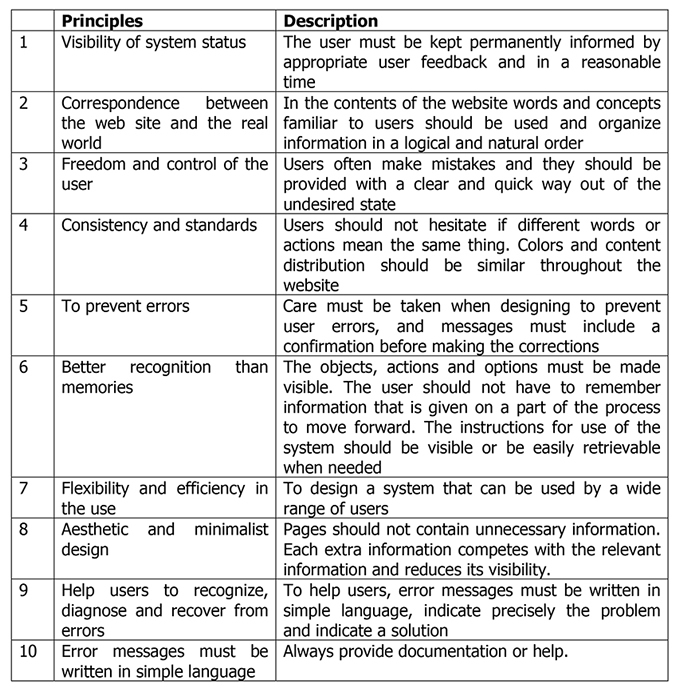
10.15198/seeci.2016.39.72-88
RESEARCH
AVATAR USE IN THE PROCESS OF LEARNING ON APPLICATIONS OF DERIVATIVES
USO DEL AVATAR EN EL PROCESO DE ENSEÑANZA-APRENDIZAJE SOBRE LAS APLICACIONES DE LAS DERIVADAS
Ricardo-Adán Salas-Rueda1 Doctor en Diseño de Nuevas Tecnologías, egresado de la Universidad Autónoma Metropolitana (UAM) en el año 2014. Durante 13 años ha impartido diversos cursos en el nivel de licenciatura y posgrado en México. Candidato a investigador nacional por parte del Sistema Nacional de Investigadores (SNI).
José-de-Jesús Vázquez-Estupiñán1
José-Luis Lugo-García1
1University La Salle. Mexico
ABSTRACT
Today, universities in Mexico are implementing various educational projects aimed at improving the teaching-learning process. For this reason, teachers are living in an era characterized by the improvement of their knowledge, skills and attitudes in pedagogical and technological areas. In fact, these higher level educational institutions are promoting the construction and use of various computer applications in order to develop skills in students. Under this scenario, the teacher in charge of the subject “Basic Mathematics for Business” has decided to use the latest technology to improve the conditions prevailing in the classroom through the creation of the System for Teaching and Learning of Mathematics (STLM), which proposes the use of the avatar and usability as a means to facilitate the assimilation and reuse of knowledge of the derivatives. STLM architecture consists of the web interface and adaptation, questionnaire and audiovisual content modules. Also, this research evaluates the impact of this system on a university located in the south of the Federal District, Mexico by the quantitative approach. This study uses a sample of 45 students using the STLM during the classroom course 2015-2, which are analyzed by descriptive statistics and ANOVA. Finally, this research proposes a technological alternative to the educational process in the area of ?mathematics.
KEY WORDS: education, new technologies, audiovisual media, distance learning, scientific research, teaching experience, teaching aids
RESUMEN:
Hoy en día, las universidades en México están implementando distintos proyectos educativos orientados a mejorar el proceso de enseñanza-aprendizaje. Por esta razón, los docentes están viviendo una etapa caracterizada por el perfeccionamiento de sus conocimientos, habilidades y actitudes en las áreas pedagógicas y tecnológicas. De hecho, estas instituciones educativas del nivel superior están promoviendo la construcción y utilización de diversas aplicaciones informáticas con el propósito de desarrollar las competencias en los estudiantes. Bajo este panorama, el docente encargado de la asignatura “Matemáticas básicas para los negocios” ha decidido utilizar la tecnología de vanguardia para mejorar las condiciones que prevalecen en el salón de clases a través de la creación del Sistema para la Enseñanza-Aprendizaje de las Matemáticas (SEAM), el cual propone el uso del avatar y la usabilidad como los medios para facilitar la asimilación y reutilización del conocimiento sobre las derivadas. La arquitectura del SEAM está compuesta por la interfaz web y los módulos de adaptación, cuestionario y contenidos audiovisuales. Asimismo, esta investigación evalúa el impacto de este sistema en una universidad ubicada en el sur del Distrito Federal, México por medio del enfoque cuantitativo. Este estudio emplea una muestra de 45 alumnos que utilizan el SEAM durante el curso presencial 2015-2, los cuales son analizados a través de la estadística descriptiva y el método ANOVA. Finalmente, esta investigación propone una alternativa tecnológica para el proceso educativo en el área de las matemáticas.
PALABRAS CLAVE: educación, nuevas tecnologías, medios audiovisuales, enseñanza a distancia, investigación científica, experiencia pedagógica, medios de enseñanza
Recibido: 21/10/2015
Aceptado: 03/12/2015
Correspondence: Ricardo Adán Salas Rueda Doctor en Diseño de Nuevas Tecnologías, egresado de la Universidad Autónoma Metropolitana (UAM
adansalas@hotmail.com
José De Jesús Vázquez Estupiñán: Universidad La Salle. México.
jjesus.vazquez@ulsa.mx
José Luis Lugo García: Universidad La Salle. México.
joseluis.lugo@ulsa.mx
1. INTRODUCTION
Currently, various universities in Mexico are considering for strategic and institutional plannings the implementation and use of technological tools in the classroom. As reported by Torres, Badillo, Valentin and Ramirez (2014), educational changes in the knowledge society require that the teaching practice includes the development of skills to meet the demands of the productive sector where the new communication media promotes vocational training and new ways of learning.
Even Padilla, Del Águila and Garrido (2015, p. 140), explained that there exists “a new profile of students with a more advanced and intensive use of IT, and that demand new features of it as a learning tool, that are entertaining and encourage their use”
The impact of new technologies in the educational process is forcing the actors of education to change the processes and tools with which knowledge is built, so that educators should be trained in concepts, procedures and attitudes of technology, and must focus their attention on forming autonomous and critical students that handle responsibly the technological resources, implying a reconsideration of the educational system (Martinez, 2014, p. 69).
In fact, teachers attending training events such as courses, seminars, workshops, study groups and postgraduate courses in education take on a new thinking for improving the teaching-learning (Pizzolitto and Macchiarola, 2015) . For this reason, various universities in Mexico are training educators on issues related to skills, teaching strategies, instructional design and computing.
According Canales (2014), the methodology for building an innovation educational settings characterized by the use of the experiences of teachers through recovery, systematization and conceptualization of knowledge. Similarly, Pizzolitto and Macchiarola (2015, p. 112) indicate that “innovations refer to a type of intentional and deliberate educational change that involves a set of calling for the introduction of educational improvements complex processes.”
For example, the Virtual Learning Environment (VLE) is an application that facilitates educational communication among participants enrolled in distance education, classroom or mixed by means of the distribution of materials in digital form such as texts, images, audio, simulations and games (Silva, 2011)
Thous and Poveda (2013) also notes that the Learning-by-doing refers to the new educational concept in which the new technologies in the field of virtual worlds and networks, represent a competitive advantage in university distance learning. In fact, there have been several investigations related to the use of the avatar in the teaching-learning process. Malik and Agarwal (2012) explain that ACALPA (Affective Computer-Aided Learning Platform for Children with Autism) is a platform that uses the avatar for feedback to the student through visual expressions related to emotions. Similarly, Falloon (2010) explains that the MARVIN application uses the avatar to present information in order to communicate different ideas and concepts to the user.
In order to efficiently face the challenges of the XXI century society, educators are incorporating the use of technology in the classroom. In particular, this research aims to design and evaluate the impact of the System for Teaching and Learning of Mathematics (STLM) as a means of educational support during the teaching of the classroom course “Basic Mathematics for business” during the school year 2015-II in a university in the south of Federal District, Mexico. It is important to mention that this study aims to use the avatar as a technological resource to improve the educational context. As mentioned by Chen, Lee, Wang Chao, Li and Lee (2012, p. 65), “the purpose of the student interaction with the avatar is to encourage and persuade users to increase participation and learning effect.”
The objectives of this research are presented next.
2. OBJECTIVES
The overall objective of this research is:
– To design, implement and evaluate the impact of STLM in the classroom course “Basic Mathematics for business” during the school year 2015-II at a university in Mexico
The specific objectives for this study are:
1. To design the architecture of STLM considering the use of the avatar
2. To implement the STLM to be used by students of the subject “Basic Mathematics for Business”
3. To evaluate the impact of the use of STLM at a university in the south of the Federal District, Mexico through ANOVA
4. To describe the elements of the architecture of the STLM
3. METHODOLOGY
According to Alayza, Cortés, Hurtado, Mory and Tarnawiecki (2013), the quantitative approach works in a standardized manner which aims to measure, make generalizations and explain. In particular, this research uses the quantitative approach to analyze the behavior of students taking the subject of “Basic Mathematics for Business” by using the STLM as a technological tool to support this course. Also, this study was conducted at a university in the south of the Federal District, Mexico with a sample of 45 students who belong to groups 101 and 102.
The hypotheses of this research are:
1. Null hypothesis (Ho): The STLM does not facilitate the teaching-learning process about the applications of derivatives during the school year 2015-2
2. Alternative hypothesis (Ha): The STLM facilitates the teaching-learning process about the applications of derivatives during the school year 2015-2
First, the architecture of STLM was designed with issues of the unit 5 denominated Applications of the derivative. Therefore, the audiovisual contents are related to different problems where it is desired to maximize or minimize a variable. It is important to mention that for the construction of STLM, this study considers as fundamental the aspect of usability by the criteria of Nielsen in order to meet the needs of the students through a quick, easy, useful and intuitive interface. In Table 1 the ten heuristic principles related Jakob Nielsen usability (Pinto, 2014) are presented.
Table 1: Heuristic principles of Jakob Nielsen

Source: Pintos, 2014
It is important that the independent variable is the use of STLM in the process of teaching-learning on the applications of derivatives and the dependent variable refers to the marks obtained by students.
After implementing the STLM, this research used the questionnaire 1 (see Annex 1) as a measuring tool to assess performance of student groups 101 and 102 before using this system. Later, the Professor of Mathematics basic course for business asked students to consult the STLM.
During the next class, the students solved again the questionnaire 1 (see Annex 1) in order to evaluate their academic performance before and after using the STLM through ANOVA (analysis of variance). As mentioned by Anderson, Sweeney and Williams (2011), this method is a statistical method of analyzing the effects of different factors in the design of experiments. Also, at this session, students completed the questionnaire 2 (Annex 2) related to the use of this web system as a support resource.
Following the discussion of this research related to the use of STLM in the teaching-learning process occurs.
4. DISCUSSION
Figure 1 shows the components that make up the architecture of STLM through a package diagram. The STLM uses the audiovisual content module to store information about the applications of derivatives, the questionnaire module to assess student performance and the control module to coordinate the elements of this application. Finally, the usable web interface enables quick and easy navigation.
Source: Authors, 2015
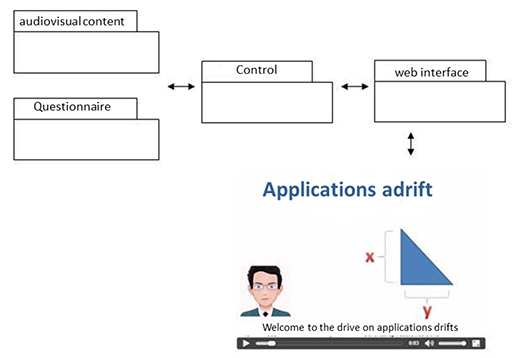
Figure 1: Architecture STLM
Figure 2 shows the process used by the STLM to present audiovisual content on the applications of derivatives.
Source: Authors, 2015
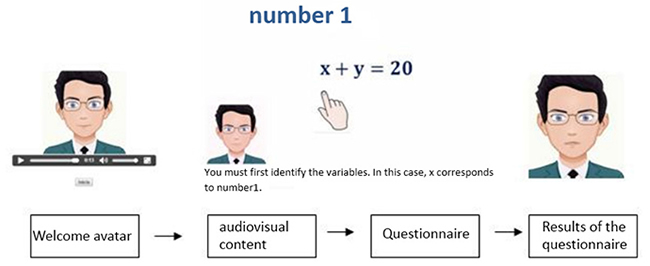
Figure 2: STLM
This research was based on the principles of Jakob Nielsen for the construction of STLM. Figure 3 shows the web interface of this system.
Source: Authors, 2015
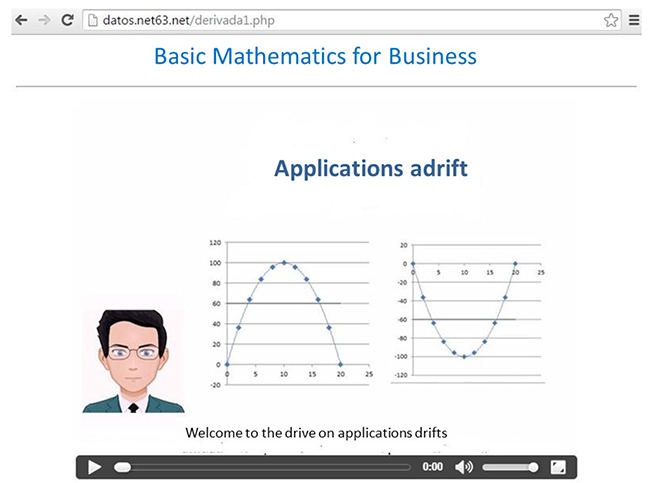
Figure 3: Web Interface STLM
Figure 4 shows some audiovisual content used by the STLM for the process of teaching and learning related to the applications of derivatives.
Source: Authors, 2015
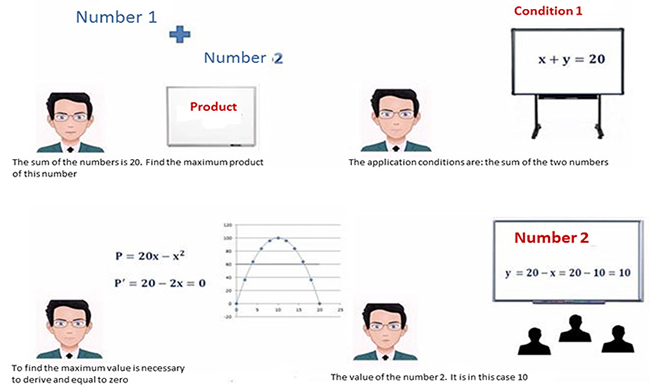
Figure 4: Audiovisual content of STLM
The use of Jakob Nielsen principles for design described STLM are described next:
1. Visibility of system status: titles are used in audiovisual content
2. Correspondence between the web site and the real world: the subtitles and the voice of audiovisual content use familiar words
3. Control and freedom of the user: the web interface provides various navigation buttons
4. Consistency and standards: the design of the web interface uses the aesthetic through the grid, readability and color
5. To prevent errors: the avatar guide the student during the teaching-learning process
6. Better recognition than memories: the user uses buttons to scroll through the web interface
7. Flexibility and efficiency in the use: STLM design uses HTML5 in order to offer students flexibility of operating systems and browsers
8. Aesthetic and minimalist design: Audiovisual content use the avatar to transmit information about the applications of the derivative
9. Help users to recognize, diagnose and recover from errors: the design of the web interface using the avatar guides the student during the teaching-learning process
10. Error messages must be written in simple language: The avatar shows the performance the student has to solve the questionnaire on the applications of derivatives
Table 2 shows the results of ANOVA with significance level of 0.05 obtained using the spreadsheet. The null hypothesis is rejected because the F value (297.42) is greater than the critical value (3.94). Therefore, the alternative hypothesis is accepted which states that the STLM facilitates the teaching-learning process about the applications of derivatives during the 2015-2 school year.
Table 2: Method ANOVA with significance level of 0.05

Source: Authors, 2015
To analyze the architecture of STLM the following aspects were evaluated:
1. Audiovisual content of STLM
2. STLM avatar to facilitate the teaching-learning process
3. Voice of the STLM
4. STLM Subtitles
5. STLM avatar to motivate the teaching-learning process
6. Interface of the STLM
The scale used to evaluate aspects related to the design and implementation of STLM is: (1) Disagrees (2) Neither agrees nor disagrees (3) Agrees (4) Strongly Agrees (5) (see Annex 2).
In Figure 1 it is shown that 57.78% of students strongly agree that the audiovisual content of the STLM facilitate the teaching-learning process about the applications of derivatives.
Source: Authors, 2015
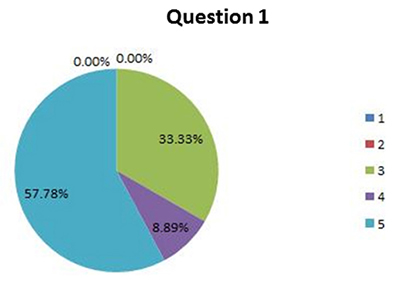
Figure 1: Audiovisual content of STLM
In Figure 2 it shows that 40% of students strongly agree that the use of the avatar in the STLM facilitates the teaching-learning process on the applications of derivatives.
Source: Authors, 2015
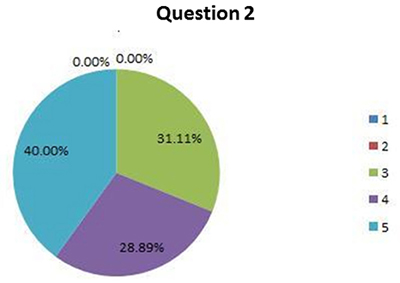
Figure 2: Avatar the STLM
In Figure 3 shows that the 51.11% of students strongly agree that the voice used in the STLM facilitates the teaching-learning process on the applications of derivatives.
Source: Authors, 2015
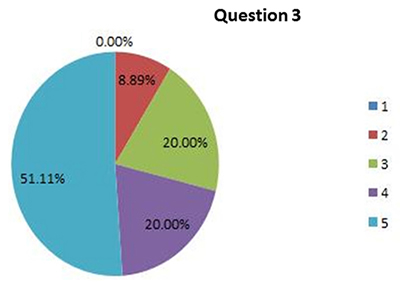
Figure 3: Voice of STLM
In Figure 4 it is shown that 51.11% of the students strongly agree that the subtitles used in STLM facilitate the teaching-learning process on the applications of derivatives.
Source: Authors, 2015
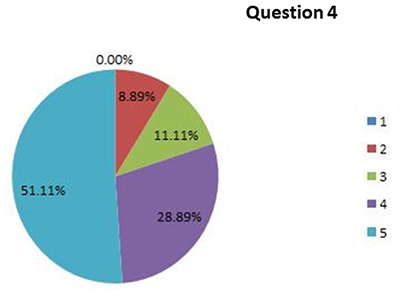
Figure 4: Subtitles of STLM
In Figure 5 it is shown that 31.11% of students strongly agree that the use of STLM avatar motivates the teaching-learning process on the applications of derivatives.
Source: Authors, 2015
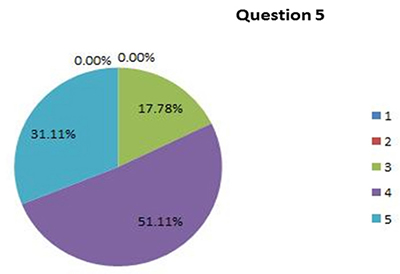
Figure 5: Using the STLM avatar as a means of motivation
Source: Authors, 2015
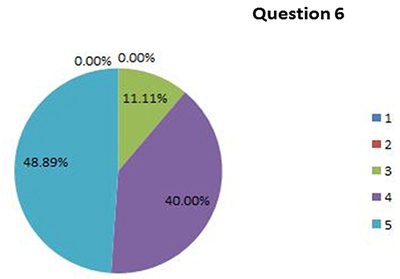
Figure 6: Web Interface of STLM
In Figure 6 it shows that 48.89% of students strongly agree that the STLM web interface facilitates the process of teaching and learning about the applications of derivatives.
5. CONCLUSIONS-RESULTS
Teachers have the opportunity to improve the educational environment through the use of computer tools. In fact Hepp, Prats and Holgado (2015) establish that the new learning scenarios have a transformative perspective that includes the training of teachers in relation to technology where educational innovations and open, flexible, creative, real and participatory digital projects are incorporated.
This research proposes the STLM architecture consisting of the web interface and questionnaire modules, audiovisual content and control to facilitate the teaching-learning process related to mathematics The control module has the function of coordinating the elements of the STLM, the questionnaire module evaluates responses provided by the user on the use of derivatives to maximize or minimize the variables, the audiovisual content module stores information about the applications of derivatives and the web interface allows convenient navigation. Furthermore, this study proposes the use of the avatar to improve the assimilation of knowledge in students.
According to Ariza and Quesada (2014, p. 110), “the literature shows that the use of digital multimedia resources in pre and post laboratory activities increases the training value of the practices of experimental sciences and optimize the time available in the face to face sessions”. Therefore, the audiovisual content presented by the STLM are designed considering usability aspects related to aesthetics (grid, legibility of the font and color) and accessibility (subtitles and voice in Spanish). Even Ongun and Demirag (2015) claim that students who use multimedia resources can plan their tasks significantly through the use of visual and audio tools.
In addition Ariza and Quesada (2014, p. 102) explains that “individuals learn significantly when they are able to make sense of new knowledge when connecting it with what they already know, or integrate it within their own cognitive schemes”. In this sense, the design of the audiovisual content of the STLM considers various applications of derivatives to maximize or minimize variables associated with reality.
Through ANOVA with a significance level of 0.05, the research states that the STLM facilitates the teaching-learning applications about the use of derivatives during the 2015-2 school year by using the avatar and usable web interface. Also surveys done in the course of Basic Mathematics for business show that 68.8% of students believe that the use of the avatar facilitated the process of teaching-learning. 82.2% of students mentioned that the avatar prompted interest in the audiovisual content of the STLM. Regarding the design of this system, 88.88% say that the web interface is simple and intuitive. In fact, Chen, Lee, Wang Chao, Li and Lee (2012) state that the design and use of avatar encourages students to continue learning.
It is recommended during the design of the web systems to HTML5 language in order to facilitate access to information. As explained by Punín, Martinez and Rencoret (2014), this language allows users to use different platforms and operating systems to surf the web. Furthermore the use of the ten heuristic principles of Jakob Nielsen for web construction systems is suggested. In particular, the web interface of STLM is designed considering the aspect of aesthetics through the grid, the readability of the font and color. It is important that the avatar guides and motivates the student during the process of teaching and learning mathematics.
Finally, teachers have the opportunity to create and / or use the latest technology to improve the conditions prevailing in the classroom. In particular, this research proposes the STLM as an educational alternative to facilitate the assimilation of knowledge about the applications of derivatives by the avatar and usable web interface.
REFERENCES
1. Anderson D, Sweeney D, Williams T (2011). Estadística para negocios y economía. México: CENGAGE Learning
2. Ariza MR, Quesada A (2014). Nuevas tecnologías y aprendizaje significativo de las ciencias. Enseñanza de las Ciencias, 32(1):101-115. doi: 10.5565/rev/ensciencias.433
3. Alayza C, Cortés G, Hurtado G, Mory, E, Tarnawiecki N (2013).Iniciarse en la investigación académica. Lima: Universidad Peruana de Ciencias aplicadas.
4. Canales-Cruz A (2014). Hacia un nuevo diseño para el aprendizaje: escenarios educativos para la Web 2.0. Apertura, 6(2):1-10. Recuperado de: http://www.udgvirtual.udg.mx/apertura/index.php/apertura/article/view/573/pdf
5. Chen GD, Lee JH, Wang CY, Chao PY, Li LY, Lee TY (2012). An Empathic Avatar in a Computer-Aided Learning Program to Encourage and Persuade Learners. Educational Technology & Society, 15 (2):62–72. Recuperado de: http://www.ifets.info/journals/15_2/7.pdf
6. Falloon G (2010), Using avatars and virtual environments in learning: What do they have to offer?. British Journal of Educational Technology, 41, 108–122. doi: 10.1111/j.1467-8535.2009.00991.x
7. Hepp K, Prats-Fernández MA, Holgado-García J (2015). Formación de educadores: la tecnología al servicio del desarrollo de un perfil profesional innovador y reflexivo. RUSC. Universities and Knowledge Society Journal, 12(2). 30-43. doi: 10.7238/rusc
8. Malik S, Agarwal A (2012). Use of Multimedia as a New Educational Technology Tool–A Study. International Journal of Information and Education Technology, 2 (5):468-471. doi: 10.7763/IJIET.2012.V2.181
9. Martínez-Solana MY (2014): Redes sociales y TIC, su papel en la educación superior del siglo XXI. Historia y Comunicación Social, 19, 63-71. doi: 10.5209/rev_HICS.2014.v19.45108
10. Ongun E, Demirag A (2015). El uso de multimedia en las tareas académicas por los estudiantes. Comunicar, 44(1):121-129. doi: 10.3916/C44-2015-13
11. Padilla-Meléndez A, Del-Águila-Obra AR, Garrido-Moreno A (2015). Using Moodle in teaching-learning processes in business management: the new profile of EHEA student. Educación XX1, 18(1):125-146. doi: 10.5944/educXX1.18.1.12314
12. Pintos-Fernández J (2014). Aplicación de técnicas de usabilidad y accesibilidad en el entorno cliente. Málaga: IC editorial.
13. Pizzolitto AL, Macchiarola V (2015). Un estudio sobre cambios planificados en la enseñanza universitaria: origen y desarrollo de las innovaciones educativas. Innovación educativa, 15(1):111-134. Recuperado de http://www.innovacion.ipn.mx/Revistas/Documents/Revistas-2015/Revista-67/UnEstudio.pdf
14. Poveda-Criado MA, Thous-Tuset MC (2013) Mundos virtuales y avatares como nuevas formas educativas. Historia y Comunicación Social, 18, 469-479. doi: 10.5209/rev_HICS.2013.v18.44262
15. Punín MI, Martínez AC, Rencoret NA (2014). Medios digitales en Ecuador: perspectivas de futuro. Comunicar, 42, 199-207. doi: 10.3916/C42-2014-20
16. Silva-Quiroz J (2011). Diseño y moderación de entornos virtuales de aprendizaje (EVA). Barcelona: UOC.
17. Torres-Rivera AD, Badillo-Gaona M, Valentin-Kajatt NO, Ramírez-Martínez ET (2014). Las competencias docentes: el desafío de la educación superior. Innovación educativa, 14 (3):129-146. Recuperado de http://www.innovacion.ipn.mx/Revistas/Documents/REVISTA-2014/revista-66/revista-66-las-competencias-docentes.pdf
AUTHORS
Adam Salas Ricardo Rueda
Doctor of Design of New Technologies, graduated from the Autonomous Metropolitan University (UAM) in 2014. For 13 years he has taught several courses related to technology, administration, education and mathematics at undergraduate and postgraduate level in various Universities in Mexico. National Researcher candidate during the period from 1 January 2016 to 31 December 2018 by the National Researcher System (SNI). As of October 1, 2015, responsible for Group Research, Development and Innovation (GRDI) of the line of Generation and Application of Knowledge in Technology at the La Salle University. ORCID: orcid.org/0000-0002-6689-4460
Jose de Jesus Vazquez Estupiñán
Bachelor in Business Administration and Journalism. Graduate in Top Management at IPADE. Master of Law from the UNAM and Doctorate in Education from the La Salle University. Postdoc at the School of Education at Texas A & M University College Station. In addition to holding several management positions within the university, he served as Director of La Salle University Morelia until 2011. Founding member of the Lasallian Youth Movement: Head of the Ministry of Youth in the government of Michoacan State and currently is Director the Faculty of Business at the La Salle University Mexico.
José Luis Lugo Garcia
Teacher of secondary education in car mechanics. Civil engineer. Master in Planning. Master of Finance. For 16 years he taught at secondary schools. He was director for 8 years in middle and high school (private). He worked at the Isec University for 23 years to High level, bachelor’s and master and the University La Salle for 21 years at the undergraduate level.